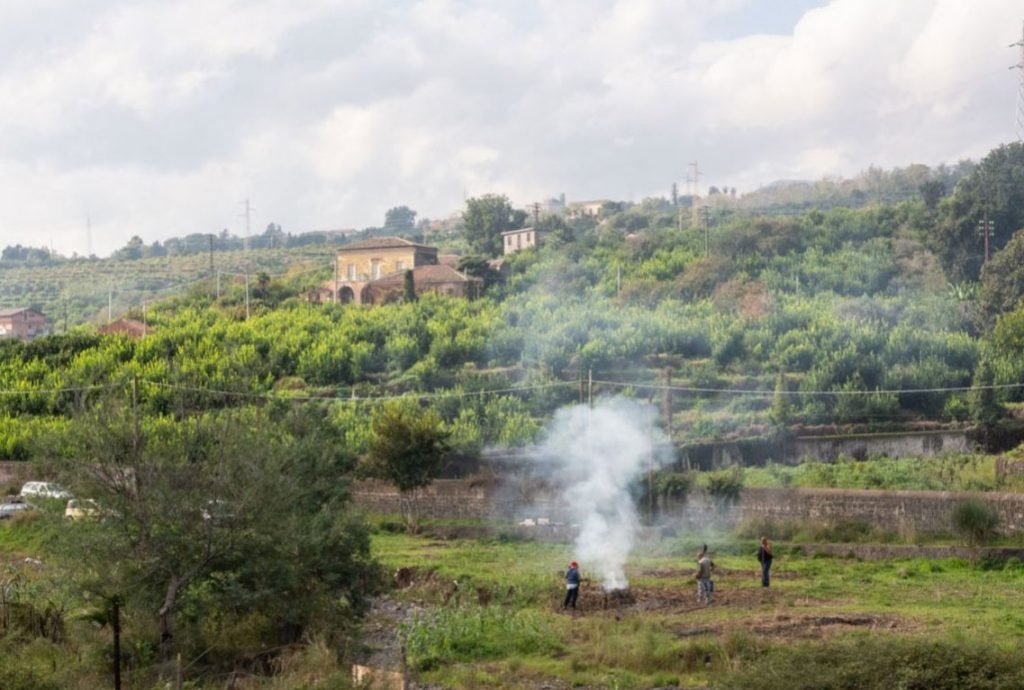Quiescenza
The arrest, the inactivity, the pause.
They are synonyms of past, present and future existence. Quiescenza offers existence to creation and existence to destruction by being absent, it allows the replacement of its state of inactivity to the state of activity. Three cyclic periods: the creation, the quiet and finally the destruction aimed at a new novel creation. In periods of quiet, space is given to internal micro-creations that merge and reproduce based on the form of inactivity, hoping for an increasingly long-lasting arrest, savouring the time and space that is offered before destruction.
The Quiescenza project was born as a reflection of belonging and territorial disappearance, between volcanic and human inactivity. Where the volcano is inactive man should be in activity, where instead volcanic activity is present man should withdraw and absent himself from his productive activities. With this contradictory rhetoric though, it can be seen how human artificiality, despite being full of productions (of any kind), tends to leave in the territory results that seem to derive not from activity but from inactivity of intentions proactive to the progression of the territory itself, in short a creation of productions of inactivity. In this case, the term Quiescenza is therefore juxtaposed and synonymous with omertà (code of silence). The operation does not want and cannot be a declaration of intent, it does not intentionally take sides or positions, but offers a neutral point of view trying to clarify the elements, attitudes and reasons that a human community has with respect to its territory or its coexistence.
The practices that a culture uses in space and time are intrinsic in the daily life of each of its components, the collective consciousness floats in the air and feeds on the living and lived territory, entering into close ties, because one (collective consciousness) is a consequence of the other (living and lived territory) or vice versa. One often perceives a desire for dominance and unbalance that leads to purely human imbalances, i.e. due and characteristic of the human attitude, these dominances are often identifiable by the activities of material or cultural production which at times is a real collaboration with the territory and the nature of the land, at other times an imposing stance. These impositions are however derivations or characteristic imitations of aspects that a territory possesses, man artificially succeeds in producing or destroying (an act that is in any case productive) by observing the methods that nature possesses and offers.
The term Quiescence means eruptive inactivity, i.e. that period of time in which its activities cease but could still be exhumed unexpectedly. The omertà, the concealment, are cultural phenomena that act with a logic very similar to that of Quiescenza. The omertà is comparable to inactivity because it makes inactive the autonomous consciousness of the thought of one man on another man, the concealment instead is comparable because it covets and hides actions, removing them from the collective knowledge, thus waiting for the exhumation of the hidden phenomenon.
This project is therefore a reflection inspired by forms of landscapes. Forms that at first sight give a static impression that lasts over time, but that they actually have a fluid, cyclic and perennial mutant life. We, people who we live on these forms, often act with awareness of an eternal approximate, we do not know or not all of us want to know, the times of the fluidity of the forms of the landscape. We relax thanks to the illusory static nature, abusing of the momentarily free space, we satisfy ourselves on the quiescence of forms and we produce stasis. We have a certain predisposition to stop matter, time, moments, with cement, with programming, with images.
When we are exposed to a constant uncertainty of stability, that is, we live with the instability of a land, of a coexistence or of a moment, we enter a state of greater sensitivity to things that surround us, with greater symbiosis with the fluidity of the forms, knowing their times, thus eliminating that illusory stillness. The cohabitation with a volcano could offer a look and an altered and unbalancing perception, no longer comforting of a fictitious immobility and durability, but destabilizing and imposing of soil fluidity. The volcano obliges the consciousness of the man who inhabits it, a constant mutation of the terrain, a perennial sense of alertness, awareness of the end of harmony and the return of dissonance.
The quiet, like the omertà was an enchantment on a break.
Raffaele Greco was born in Giarre (CT) on 17/06/1994 where he grew up and faced his first artistic studies. In 2013 he enrolled at the Brera Academy in Milan where his first exhibition experiences began, in 2016 he was selected for an artistic residence in the region of Hangzhou, China. Graduated in Painting in 2017, he enrolled in the specialization in sculpture at Brera. At the end of 2018 he opened a workshop and exhibition space in Milan called “Studio Scalzo” together with the artists Simona Pavoni and Antonio Perticara, with whom he realized different collaborations. In 2019 he was selected among the artists of the Art Biennale of Monza where he was awarded the first prize “Massimo Viscardi” for photography for the installation and film work “Quiescenza”. He currently studies and works between Catania and Milan.




